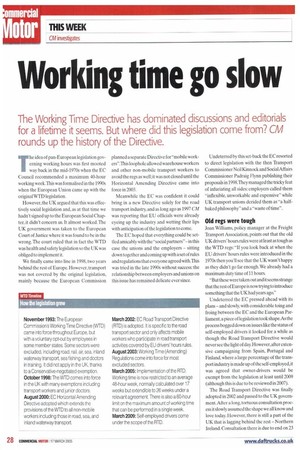Working time go slow
Page 28

Page 29

If you've noticed an error in this article please click here to report it so we can fix it.
The Working Time Directive has dominated discussions and editorials for a lifetime it seems. But where did this legislation come from? CM rounds up the history of the Directive.
The idea of pan-European legislation governing working hours was first mooted way back in the mid-1970s when the EC Council recommended a maximum 40-hour working week.This was formalised in the 1990s when the European Union came up with the original WTD legislation.
However, the UK argued that this was effectively social legislation and, as at that time we hadn't signed up to the European Social Chapter, it didn't concern us. It almost worked. The UK government was taken to the European Court of Justice where it was found to be in the wrong. The court ruled that in fact the WTD was health and safety legislation so the UK was obliged to implement it.
We finally came into line in 1998, two years behind the rest of Europe. However, transport was not covered by the original legislation, mainly because the European Commission planned a separate Directive for "mobile workers".This loophole allowed warehouse workers and other non-mobile transport workers to avoid the regs as well; it was not closed until the Horizontal Amending Directive came into force in 2003.
Meanwhile the EC was confident it could bring in a new Directive solely for the road transport industry, and as long ago as 1997 CM was reporting that EU officials were already eyeing up the industry and wetting their lips with anticipation of the legislation to come.
The EC hoped that everything could be settled amicably with the "social partners"-in this case the unions and the employers sitting down together and coming up with a set of rules and regulations that everyone agreed with.This was tried in the late 1990s without success: the relationship between employers and unions on this issue has remained delicate ever since. Undeterred by this set-back the EC resorted to direct legislation with the then Transport Commissioner Neil Kinnock and Social Affairs Commissioner Padraig Flynn publishing their proposals in 1998.They managed the tricky feat of infuriating all sides: employers called them "inflexible, unworkable and expensive" while UK transport unions derided them as "a halfbaked philosophy" and a "waste of time".
Old regs were tough
Joan Williams, policy manager at the Freight Transport Association, points out that the old UK drivers' hours rules were at least as tough as the WTD regs: "If you look back at when the EU drivers' hours rules were introduced in the 1970s then you'll see that the UK wasn't happy as they didn't go far enough. We already had a maximum duty time of 11 hours.
"But these were taken out and it seems strange that the rest of Europe is now trying to introduce something that the UK had years ago."
Undeterred the EC pressed ahead with its plans and slowly, with considerable toing and froing between the EC and the European Parliament, a piece of legislation took shape.As the process bogged down on issues like the status of self-employed drivers it looked for a while as though the Road Transport Directive would never see the light of day. However, after extensive campaigning from Spain. Portugal and Finland, where a large percentage of the transport industry is made up of the self-employed, it was agreed that owner-drivers would be exempt from the legislation at least until 2009 (although this is due to be reviewed in 2007).
The Road Transport Directive was finally adopted in 2002 and passed to the UK government. After a long, tortuous consultation process it slowly assumed the shape we all know and love today. However, there is still a part of the UK that is lagging behind the rest Northern Ireland. Consultation there is due to end on 23 March and reference periods will begin, apparently, five days later.
However as Williams points out,the authorities in Northern Ireland have yet to produce the legislation and it's unlikely to start on time there.
Elsewhere in Europe the picture is equally confused. In the Irish Republic the legislation is meant to start "towards the end of March", but no-one's sure exactly when. Jimmy Quinn, director of communications at the Irish Road Haulage Association, says: "It looks like it's going to happen but everyone's scratching their heads as to how it's going to work.
"Naturally people are very worried about it and wonder whether we are going to treat it like we do with other laws in this country, where we take it in and ignore it.We are very big on legislation but very light on enforcement."
Quinn adds that very few hauliers or drivers are in favour of the legislation.
Not before October
Over in the Netherlands hauliers won't have to worry about the Directive until October at the earliest. Esther Vorenkarnp from Dutch haulage association Transport en Logistiek Nederland explains: "The bottom line is that it is not possible to transfer the WTD into Dutch legislation before 23 March; it has been postponed until the fourth quarter of 2005.
"It needs a driver to go to court to see if the legislation can be applied sooner."
In Germany there are also problems with the legislation. German transport journalist Jan Bcrgrath adds: "Hauliers here don't give a damn — they are more concerned with the amount of work they are losing to eastern Europe and with the Maul [motorway toll].
"It is also not going to be enforced until digital tachos are in place," he says.
In France,however,where drivers already work shorter hours than the legislation requires, the Directive is passing almost without comment, •










































































































































































































